-

-
Courses
Find courses by:
Collections
Cross-Disciplinary Topic Lists
- About
- Donate
- Featured Sites
This is an archived course. A more recent version may be available at ocw.mit.edu.
Each character entry below contains a ≤1 MB QuickTime movie of the character being painted with a brush, created by Prof. Saeko Komori of Chubu University. Please see the JP Net Kanji Project for more details.
In the following definitions, on (Chinese-based) readings are represented by katakana, and by capital romaji letters; kun (native Japanese-based) readings are represented by hiragana, and by lower-case romaji letters. This is a common dictionary convention, and does not have any bearing on meaning.

Stroke order: (MOV)
Printed form: 一
Readings: イチ/イッ- ICHI/IT-
Meaning: one
Mnemonic:
A single straight horizontal line.
Usage examples:
一ばん (いちばん) No. 1
一セント (いっセント) one cent
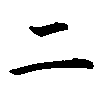
Stroke order: (MOV)
Printed form: 二
Readings: ニ NI
Meaning: two
Mnemonic:
Two horizontal straight lines.
Usage examples:
二ドル (にドル) two dollars

Stroke order: (MOV)
Printed form: 三
Readings: サン SAN
Meaning: three
Mnemonic:
Three straight horizontal lines.
Usage examples:
三セント (さんセント) three cents
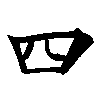
Stroke order: (MOV)
Printed form: 四
Readings: シ/よ-/よん SHI/yo-/yon
Meaning: four
Mnemonic:
Number 八(eight) inside a box. It is cut in half. [shi] is a reading when counting 1, 2, 3...
Usage examples:
四ドル (よんドル) four dollars
四十四円 (よんじゅうよえん) 44 yen
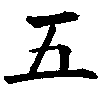
Stroke order: (MOV)
Printed form: 五
Readings: ゴ GO
Meaning: five
Mnemonic:
Japanese people count numbers by folding fingers from thumb to little finger. The original character X (Roman numeral 10) symbolizes fingers crossing each other.
Usage examples:
二十五セント (にじゅうごセン) 25 cents
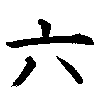
Stroke order: (MOV)
Printed form: 六
Readings: ロク ROKU
Meaning: six
Mnemonic:
A picture of a human with six essential parts: head, two arms, two legs, and main body (invisible).
Usage examples:
六十円 (ろくじゅうえん) 60 yen

Stroke order: (MOV)
Printed form: 七
Readings: シチ/なな- SHICHI/nana-
Meaning: seven
Mnemonic:
七 appears in 切 "to cut with sword". The horizontal line is cut with a vertical line.
Usage examples:
七ドル (しちドル) seven dollars
七十七 (ななじゅうなな) 77
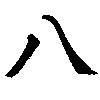
Stroke order: (MOV)
Printed form: 八
Readings: ハチ/ハッ HACHI/hat-
Meaning: eight
Mnemonic:
The two strokes are almost symmetrical. The number eight is an easy number to divide.
Usage examples:
八ドル八セント (はっセント) 8 dollars and 8 cents
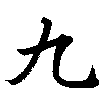
Stroke order: (MOV)
Printed form: 九
Readings: キュウ/ク KYUU/KU
Meaning: nine
Mnemonic:
A picture of an arm bending and stiffening the muscle. 九 has the meaning "draw together" to conclude the counting from 1 to 10.
Usage examples:
九ドル (きゅうドル) nine dollars
十九 (じゅうく) 19
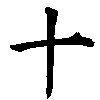
Stroke order: (MOV)
Printed form: 十
Readings: ジュウ/ジュッ-/ジッ- JUU/JUT-/JIT-
Meaning: ten
Mnemonic:
A picture of many sticks bundled together with a string.
Usage examples:
四十セント (よんじっセント) 40 cents
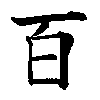
Stroke order: (MOV)
Printed form: 百
Readings: ヒャク (-ピャク/-ビャク) HYAKU (-PYAKU/-BYAKU)
Meaning: hundred
Mnemonic:
The beginning number 一 and 白 "white". Imagine a bowl of rice containing a hundred of white rice grains.
Usage examples:
百ドル (ひゃくドル) 100 dollars
三百 (さんびゃく) 300

Stroke order: (MOV)
Printed form: 千
Readings: セン (-ゼン) SEN (-ZEN)
Meaning: thousand
Mnemonic:
The combination of 一 (symbol of "number") and イ "person". What is abundant on earth? People.
Usage examples:
千ドル (せんドル) 1000 dollars
三千六百 (さんぜんろっぴゃく) 3600
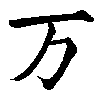
Stroke order: (MOV)
Printed form: 万
Readings: マン MAN
Meaning: ten thousand
Mnemonic:
The unit of ten thousand. The character came from an image of a swastika, symbolizing "all" and "all possible directions".
Usage examples:
一万 (いちまん) 10000
五百万 (ごひゃくまん) 5000000

Stroke order: (MOV)
Printed form: 円
Readings: エン EN
Meaning: yen
Mnemonic:
Money machine at a bank.
Usage examples:
千百円 (せんひゃくえん) 1100 yen
一万九千円 (いちまんきゅうせんえん) 19000 yen
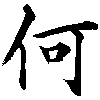
Stroke order: (MOV)
Printed form: 何
Readings: なに/なん- nani/nan-
Meaning: what; how many
Mnemonic:
Two persons イイ carrying a box 口. The sight draws the attention of people and they ask "What is inside?"
Usage examples:
何ですか (なんですか) What is it?
何ばんですか (なんばんですか) What number is it?
[Quizzes (JavaScript required): Meaning (13 questions) | Reading (13 questions) | Character Recognition (4 questions)]